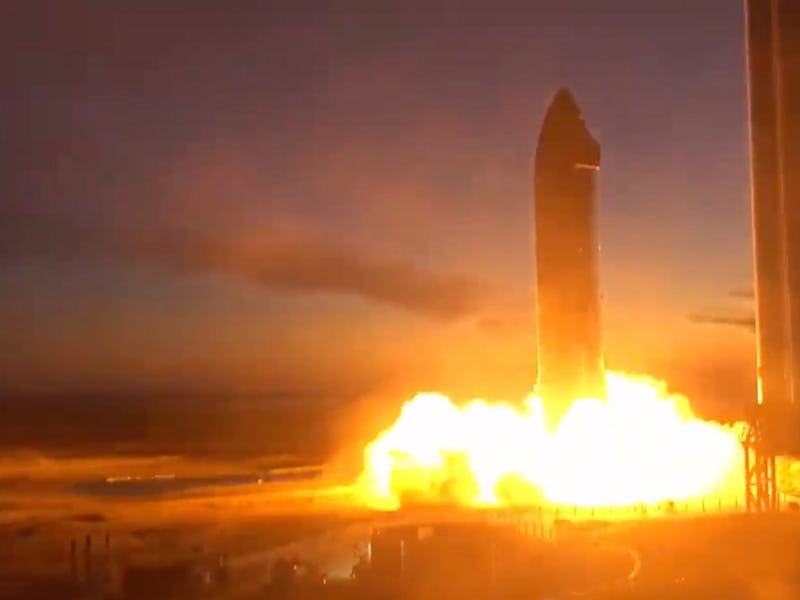
The Starship, SpaceX’s under-development rocket, is turning up the power.
In a video shared via Twitter last week, the space-faring company hosted a static test fire of a prototype Starship rocket. The ship, designed to send the first humans to Mars and establish a city, is currently undergoing testing at SpaceX’s facilities in Texas. This is the first time that the Starship has fired a vacuum variant of its Raptor engine, specifically optimized to propel the rocket through the depths of space.
The test fire marks another step forward in CEO Elon Musk’s overall mission to establish a city of 1 million people on Mars by 2050. To achieve this goal, Musk has calculated that SpaceX will need to send around one million tons of cargo to the planet.
The Starship, when paired with the Super Heavy booster, is designed to transport around 100 tons to Mars at a time — which means SpaceX will need to host around 10,000 flights to Mars.
The vacuum variant of the Raptor engine is key to achieving this. The Super Heavy booster, which lifts the Starship away from Earth, is expected to feature 33 Raptor engines optimized for use in the atmosphere at sea level. The Starship, which detaches from the Super Heavy to complete the journey, will feature three sea-level and three vacuum Raptor engines.
In the dim light over the Texas facility, SpaceX demonstrated this powerful rocket with a fiery display.
Want to find out more about SpaceX’s plans to reach Mars and beyond? Subscribe to MUSK READS+ for exclusive interviews and analysis about spaceflight, electric cars, and more.
SpaceX’s vacuum Raptor: What to know
The vacuum variant of the Raptor engine is optimized to better propel the rocket as it moves through space.
A previous size comparison by SpaceX shows it’s not just a minor tweak: the vacuum variant is gargantuan.
The first SpaceX Raptor vacuum engine, captured before it shipped from SpaceX’s factory in California to the rocket development site in Texas.
So why is it so much bigger? Because of the difference in pressure out in space.
NASA explains that, in the simplest terms, a rocket engine sends out hot gases through a nozzle to produce thrust. The design is based on Newton’s third law: for every action, there is an equal and opposite reaction. Gas pushes out through the nozzle, and the engine gets pushed forward in return.
The Mars Society of Canada, which advocates for exploring the planet with rockets like Starship, explains that making the nozzle larger forces the gas out onto a wider area and increases the thrust. The problem is when the gas expands out so much that the pressure is lower than the surrounding atmosphere, so the atmosphere pinches the gas and pushes it away from the nozzle walls.
Various nozzle sizes. While the top one is underexpanded, the bottom two are overexpanded. The middle one is the optimal size for the surrounding pressure.
An overexpanded nozzle leads to what’s known as flow separation, which can cause damage to the engine.
Of course, atmospheric pressure isn’t a problem in the atmosphere-free vacuum of space. That would suggest SpaceX could keep making the nozzle larger and larger, but there are practical limits to this.
So how was SpaceX able to fire this vacuum engine at sea level without encountering issues? Musk claimed on Twitter, in response to a question from YouTuber Everyday Astronaut, that the engine has a “very high chamber pressure” that allows it to be fired at sea level without suffering from flow separation.
How much more powerful is this variant? One measure is specific impulse, or how much push comes from a set unit of fuel. Musk claimed in September 2019 that, where the sea-level Raptor variant could reach a specific impulse of 350 seconds, the vacuum variant could reach 380 seconds.
When you’re trying to establish humans as a multi-planet species, every boost helps.
SUBSCRIBE TO MUSK READS+, A PREMIUM NEWSLETTER THAT COVERS THE WORLDS OF ELON MUSK, SPACEX, TESLA, AND EVERYTHING BETWEEN.